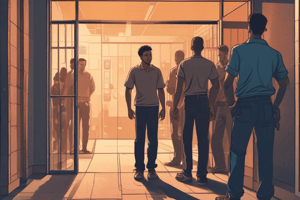Podcast
Questions and Answers
During which time period were troubled children offered intervention efforts focused on family control?
During which time period were troubled children offered intervention efforts focused on family control?
- 1750-1850 (correct)
- 1850-1890
- 1899-1920
- 1920-1960
What were almshouses?
What were almshouses?
- Small, rural, cottage-like homes run by parental figures who worked to educate and care for the children and adolescents.
- Locked, one-room buildings that housed many types of people with many different problems, including troubled or orphaned children. (correct)
- Facilities that were substandard and overcrowded, did not include rehabilitative services or medical care, and employed a controlling and punitive environment.
- Community-based corrections such as group homes, partial release supervision, and halfway houses.
What was the purpose of the Child Saving Movement?
What was the purpose of the Child Saving Movement?
- To establish juvenile courts
- To control troubled, wayward, or orphaned children
- To treat delinquency as a social problem instead of a crime
- To keep children sheltered, fed, and employed (correct)
How were reform schools designed?
How were reform schools designed?
When were juvenile courts established?
When were juvenile courts established?
Who worked with the child and family to guide the decision-making of juvenile courts?
Who worked with the child and family to guide the decision-making of juvenile courts?
What was the primary determination and outcome for those involved with the juvenile courts during the 1920-1960 time period?
What was the primary determination and outcome for those involved with the juvenile courts during the 1920-1960 time period?
What were the conditions like in the facilities during the 1920-1960 time period?
What were the conditions like in the facilities during the 1920-1960 time period?
What were community-based corrections introduced during the 1920-1960 time period?
What were community-based corrections introduced during the 1920-1960 time period?
What was the purpose of houses of refuge?
What was the purpose of houses of refuge?
Flashcards are hidden until you start studying
Study Notes
- 1750-1850: Troubled children were offered intervention efforts focused on family control.
- Almshouses were colonial-era, locked, one-room buildings that housed many types of people with many different problems, including troubled or orphaned children.
- Houses of refuge were established in major cities to help control troubled, wayward, or orphaned children.
- 1850-1890: The Child Saving Movement focused on the urban poor, trying to keep children sheltered, fed, and employed.
- Reform schools were designed as small, rural, cottage-like homes run by parental figures who worked to educate and care for the children and adolescents.
- 1899-1920: Establishment of Juvenile Courts treated delinquency as a social problem instead of a crime.
- Probation officers, social workers, and psychologists worked with the child and family, as well as to guide the decision-making of juvenile courts.
- 1920-1960: Institutionalization became the primary determination and outcome for those involved with the juvenile courts.
- Facilities were substandard and overcrowded, did not include rehabilitative services or medical care, and employed a controlling and punitive environment.
- Community-based corrections were introduced, such as group homes, partial release supervision, and halfway houses.
Studying That Suits You
Use AI to generate personalized quizzes and flashcards to suit your learning preferences.




